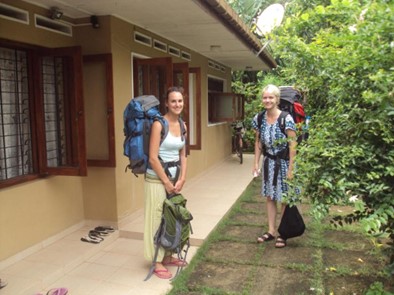Sri Lanka boasts over 1,000 homestay units registered with the Sri Lanka Tourism Development Authority (SLTDA) with perhaps an even larger number operating without licenses, unregulated.
Currently, there is a surge of arrivals to Sri Lanka, with all hotels and smaller accommodation units enjoying high occupancy levels. In this context, there are differing views on the importance of homestays in the Sri Lankan tourism portfolio.
While some argue that homestays are a vital component of Sri Lanka’s tourism product offering, others contend that certain homestays may damage the reputation and quality.
In an effort to provide a comprehensive perspective on this matter, this study will discuss in detail several of these issues and attempt to arrive at some conclusions.
Introduction to Homestays and its operation in the West and East
Homestays, a significant segment in the tourism industry, offer travellers an immersive experience to the local culture and lifestyle. In Sri Lanka, SLTDA defines a homestay as “a house occupied by a family with one room, up to four guest rooms, ready to accommodate tourists where the tourist and the hosting family interact with each other.” The primary aim is to provide tourists with an authentic taste of Sri Lankan cuisine and culture, infused with the hospitality of the hosting family.
The international perception of homestays, however, often revolve around a more transactional approach fundamentally looking at a long term stay than in the local context, where travellers pay for accommodation without necessarily expecting a deep interaction with the hosting family.
Thus,
- There is a vast difference between Western and Eastern region homestays
- Asian homestays are generally of a smaller nature (i.e. Number of rooms)
- Asian homestays are at the lower end of the price spectrum of tourism, compared to conventional hotels.
- International homestays however take more of a transactional nature and mostly involves international / exchange students
Basis of study
In undertaking a study such as this, there are several challenges to be faced due to the unavailability of any proper literature on the subject, and reliable data sources.
- Informality issue
As mentioned earlier, Sri Lankan homestays are smaller units, which therefore fall into the Micro and Small Enterprises (MSE) category. Most of such homestays are of an informal nature with limited formal registration with the relevant tourism authorities. There is speculation that the unregulated number may be larger than the regulated category. As such there is a paucity of data on homestays available.
- Rationale for obtaining data
For a study such as this, there is the need to use certain strategies and derive necessary data from peripheral sources with assumptions and calculations. Available information will be referred to, supported by some conservative assumptions made on the authors’ experience in working in this sector for several years.
Homestays operate extensively through OTAs and therefore OTAs would have ideally been the best source to obtaining data. However, this data is not publicly available.
Estimation of the actual size of the total Homestay category in Sri Lanka
SLTDA statistics indicate that there were 1,080 homestay units registered with a total of 3,231 rooms.
However, the challenge is to estimate the number of unregistered homestay units. There is a paucity of information regarding this and limited academic literature to go by. The few available sources indicate that there are wide ranging estimates of the unregistered (informal) sector amounting to an average of about 70% which will be used for the study[1]
Hence there will be about 1,037 x 70% = 761 in the informal sector.
Hence
Registered Homestay units with SLTDA 1,080
Unregistered Homestay units as computed above 756
Total estimated homestay units 1,836
Computation of the Earnings of the homestay market
As a first step, the total number of homestay units derived from the above calculations, has to be converted to number of rooms.
Based on the latest 2023 SLTDA statistics, a homestay unit in Sri Lanka has an average of 3 rooms per unit.
For a total of 1,836 homestay units the total number of rooms can be thus derived easily.
Hence, total number of homestay rooms available would be 1,836 x 3 = 5,508
From extensive key informant interviews, the authors’ own experience, and analysis of some of the listings on Online Tour operators (OTAs), the average homestay rate is in the range of USD 20-30 per room in Sri Lanka.
Hence, the average room rate of a homestay is taken to be about USD 25
The informal sector occupancy is estimated to be about 62%.
Hence, the average occupancy of homestays for 2023 is taken as 62%
Calculation of total earnings of the homestay units is now straightforward (5,508 rooms @USD 25 and occupancy of 62% for the year)
Hence, total estimated earnings from homestays for 2023 would be in the order of USD 31,161,510
Sri Lanka’s Total Tourism earnings for 2023 was USD 2,067,000,000[2]
Hence earnings from homestays for 2023 account only for 1.51% of the total earnings from tourism.
To provide a clearer perspective, a prominent 5-star city hotel announced recently that their earnings for the first 9 months of FT2024 were Rs 2.7 billion (approximately USD 9 million).[3] Based on the above analysis, the total homestay earnings for the entire year of 2023 are estimated to be USD 31 million. Therefore, it can be observed that a typical 5-star city hotel earns more than one-third of the total annual earnings of the entire homestay market in just 9 months!
Conclusion
- The financial contribution is relatively small: Homestays play an important role in expanding Sri Lanka’s tourism portfolio, despite their limited financial contribution compared to larger hotels. Their affordability and authenticity appeal to a specific market segment seeking immersive cultural experiences. However, it is important to highlight that their impact goes beyond financial metrics, particularly when considering the socioeconomic benefits, they offer to local communities engaged in tourism.
- Importance of Sri Lanka’s marketing and destination branding: Homestays play an important part in Sri Lanka’s marketing and destination branding since they offer authentic tourist experiences. Despite being regarded as ‘low-end’ tourism, they reflect the essence of Sri Lankan hospitality and culture, attracting travellers seeking unique experiences. Incorporating homestays into destination marketing initiatives has the potential to differentiate Sri Lanka from the competition and attract niche tourists seeking authentic, out-of-the-ordinary experiences.
- Impact on tourism arrivals: Even though homestays may not draw large volumes of tourists individually, they help improve Sri Lanka’s overall appeal as a travel destination. Their presence adds diversity to the accommodation options available and appeals to travellers with varying preferences and budgets. Homestays are also important in spreading tourism to remote or less-visited areas, supporting more inclusive and sustainable tourism across the country. Hiriketiya, Ahangama, and Dikwella, which are towns located beyond the traditionally popular destinations like Galle and Hikkaduwa, are already seeing lasting multiplier and spin-off effects that have been encouraged by this distribution. Therefore, it is important to recognise their presence as they continue to enhance the economic and social benefits beyond popular tourist destinations.
- Value Proposition: Homestays improve the lives of many locals while encouraging community engagement and contributing to the overall ecosystem of the tourism sector, even though their financial impact may be relatively small.
Way forward
- Importance of formalization: Recognizing the significance of homestays in Sri Lanka’s tourism landscape, it is essential to consider various strategies to formalize and integrate their operations into the formal sector, either by bringing them into the fold or adopting a quasi-legal approach.
However, the primary purpose of formalization should not be to increase taxation revenue, a topic much discussed today. As shown in the analysis above, the revenue accruing to the government from homestays is miniscule.
Instead, formalization should focus on providing support and incentives for homestay operators to comply with regulatory requirements and quality standards. Initiatives such as capacity-building workshops, certification programs, and financial assistance schemes can empower homestay hosts and enhance the overall professionalism and quality of the sector. While encouraging homestay establishments to register with the SLTDA ensures regulatory compliance and a contribution to the national economy through taxation, the emphasis should be on the broader benefits. By formalizing their operations, homestay owners can also gain access to additional services and marketing opportunities provided by the SLTDA, further enhancing their visibility and competitiveness in the market.
- Capacity building and training: Developing effective and practical training programs is essential to improve the hospitality skills of homestay hosts, which will enhance the quality of services provided. These programs should cover key areas such as hygiene, health and food safety, customer service, and cultural sensitivity to ensure a favourable guest experience and minimize potential issues. Digital marketing must also be an area covered as many homestay operators and hosts lack digital marketing knowledge and as observed, many homestays lack digital presence online. By investing in the professional development of homestay hosts, Sri Lanka can elevate the overall quality and competitiveness of its tourism product, attracting a wider range of visitors.
It’s important to acknowledge the efforts made by SLTDA in conducting extensive training initiatives with limited resources. However, further improvements are necessary to enhance the effectiveness of these training efforts.
- Collaboration with stakeholders: Collaboration between government agencies, stakeholders involved in tourism, private sector industry associations, and local organizations is essential to address the challenges faced by the homestay sector. This includes streamlining regulatory processes, promoting best practices, and facilitating access to financial and technical assistance. By working together, stakeholders can create a supportive environment for the sustainable growth of the homestay sector, ensuring that it continues to contribute positively to Sri Lanka’s tourism industry and economy.
The Authors
Srilal Miththapala is a tourism professional with over 30 years’ experience. He has been a past president of The Tourist Hotels Association of Sri Lanka and now works as a consultant to one of the leading international funding agencies.
Dewni Aluthwatte is an experienced professional in the development sector, specializing in project and program management. She currently works as a consultant for a prominent international funding agency.
(The views expressed in this study are specifically of the authors only, and in no way reflect the views of the respective authors employers, companies, institutions or other associated parties they may be associated with).
(eTN): Sri Lanka Homestays: Important in Main-Stream Tourism? | re-post license | post content























